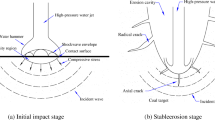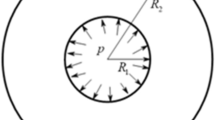Abstract
Lateral pressure coefficient is an important parameter in geological engineering, and it influences significantly the damage zone around boreholes. In accordance with the fundamental principles of the Particle Flow Code (PFC), various models were established to investigate the crack propagation patterns and energy evolution rules of coal in disturbed zones of hydraulic slotting for various lateral pressure coefficients. Cracks around a slotted borehole propagate in the horizontal direction when the lateral pressure coefficient λ is less than 1, distribute uniformly when λ is equal to 1, and extend mostly in the vertical direction when λ is greater than 1. The total number of cracks increases linearly with λ. The variation in kinetic energy for coal failure was recorded; kinetic energy evolution observes a similar rule and its process can be divided into four stages, namely, the quick-release, rapid dissipation, drastic fluctuation, and stabilized stages. The peak value of the kinetic energy increases linearly with λ. The acoustic emission events distribute discretely when λ is small and uniformly when λ is equal to 1. The variation in acoustic emission events tends to increase sharply before decreasing when λ is greater than 1. The research findings are significant to the exploration of pressure relief mechanisms for hydraulic slotting from a microcosmic perspective.
















Similar content being viewed by others
References
Al-Busaida, Hazzard A, Young JF et al (2005) Distinct element modeling of hydraulically fractured Lac du Bonnet granite. J Geophys Res Solid Earth 110(B6):1–14, B06302
Cai M, Kaiser PK, Morioka H et al (2007) FLAC/PFC coupled numerical simulation of AE in large-scale underground excavations. Int J Rock Mech Min Sci 44(4):550–564
Cho N, Martin CD, Sego DC (2007) A clumped particle model for rock. Int J Rock Mech Min Sci 44(7):997–1010
Cundall PA, Strack ODL (1979) A discrete numerical model for granular assemblies. Geotechnique 29:47–65
Damjanac B, Board M, Lin M et al (2007) Mechanical degradation of emplacement drifts at Yucca Mountain-A modeling case study PartII: Lithophysal rock. Int J Rock Mech Min Sci 44:368–369
Deng XF, Zhu JB, Chen SG et al (2014) Numerical study on tunnel damage subject to blast-induced shock wave in jointed rock masses. Tunn Undergr Space Technol 43:88–100
Detournay E, Peirce A (2014) On the moving boundary conditions for a hydraulic fracture. Int J Eng Sci 8:147–155
Etchells P (1997) Cutting head design lowers abrasive water jet cutting costs. Aircr Eng Aerospace Technol 69:147–150
Folkes J (2009) Waterjet—an innovative tool for manufacturing. J Mater Process Technol 209:6181–6189
Hao ZY, Zhou C, Lin BQ et al (2014) Pressure-relief and permeability-increase technology of high liquid–solid coupling blast and its application. Int J Min Sc Technol 24(1):45–49
Itasca Consulting Group Inc (2004) PFC2D (Particle Flow Code in 2 Dimensions), Version 3.1 1–1313
Iuspa L, Fusco P, Ruocco E (2015) An improved GPU-oriented algorithm for elastostatic analysis with boundary element method. Comput Struct 146:105–116
James LA (2005) Sediment from hydraulic mining detained by Englebright and small dams in the Yuba basin. Geomorphology 71:202–226
Michael J, Daniel B (2010) Fractal model for permeability calculation from porosity and pore radius information and application to excavation damaged zones surrounding waste emplacement boreholes in opalinus clay. Int J Rock Mech Min Sci 47:583–589
Kahlman L, Öjmertz KMC, Falk LKL (2001) Abrasive-waterjet testing of thermo-mechanical wear of ceramics. Wear 248:16–28
Kekec B, Kemal M, Bilim N (2014) Evaluation of the effect of vibrational wave propagation of different artificial discontinuous planes in rock samples. Arab J Geosci. doi:10.1007/s12517-014-1647-9
Kim MC, Chun HH, Kim HY et al (2009) Comparison of waterjet performance in tracked vehicles by impeller diameter. Ocean Eng 36:1438–1445
Kulekci MK (2002) Processes and apparatus developments in industrial waterjet applications. Int J Mach Tools Manuf 42:1297–1306
Li LC, Tang CA, Wang SY et al (2013) A coupled thermo-hydrologic-mechanical damage model and associated application in a stability analysis on a rock pillar. Tunn Undergr Space Technol 34:38–53
Li XB, Cao WZ, Zhou ZL et al (2014) Influence of stress path on excavation unloading response. Tunn Undergr Space Technol 42:237–246
Liang YP (2007) Study on the mechanism of coal failure by drilling of high pressure water jetting, PhD thesis, Shandong University of Science and Technology, Jinan (in Chinese)
Lin BQ, Zhang JG, Shen CM et al (2012) Technology and application of pressure relief and permeability increase by jointly drilling and slotting coal. Int J Min Sci Technol 22:545–551
Lu YY, Liu Y, Li XH, Kang Y (2010) A new method of drilling long boreholes in low permeability coal by improving its permeability. Int J Coal Geol 84:94–102
Lu TK, Zhao ZJ, Hu HF (2011) Improving the gate road development rate and reducing outburst occurrences using the water jet technique in high gas content outburst-prone soft coal seam. Int J Rock Mech Min Sci 48:1271–1282
Lu TK, Yu H, Zhou TY et al (2013) Improvement of methane drainage in high gassy coal seam using water jet technique. Int J Coal Geol 79:40–48
Mayoral JM (2014) Performance evolution of tunnels built in rigid soils. Tunn Undergr Space Technol 43:1–10
Nabawy BS (2014) Estimating porosity and permeability using digital image analysis (DIA) technique for highly porous sandstones. Arab J Geosci 7(3):889–898
Ni GH, Lin BQ, Zhai C et al (2014) Kinetic characteristics of coal gas desorption based on the pulsating injection. Int J Min Sci Technol 24(5):631–636
Park WG, Jang JH, Chun HH et al (2005) Numerical flow and performance analysis of waterjet propulsion system. Ocean Eng 32:1740–1761
Potyondy DO (2007) Simulating stress corrosion with a bonded-particle model for rock. Int J Rock Mech Min Sci 44:677–691
Potyondy DO, Cundall PA (2004) A bonded-particle model for rock. Int J Rock Mech Min Sci 41:1329–1364
Sato K, Isobe T, Mori N et al (1986) Microseismic activity associated with hydraulic mining. Int J Rock Mech Min Sci Geomech Abstr 23(1):85–94
Shanmugam DK, Nguyen T, Wang J (2008) A study of delamination on graphite/epoxy composites in abrasive waterjet machining. Compos Part A 39:923–929
Shen CM, Lin BQ, Meng FW et al (2012) Application of pressure relief and permeability increased by slotting a coal seam with a rotary type cutter working across rock layers. Int J Min Sci Technol 22:533–538
Shimizu H, Murata S, Ishida T (2011a) The distinct element analysis for hydraulic fracturing in hard rock considering fluid viscosity and particle size distribution. Int J Rock Mech Min Sci 48(5):712–727
Shimizu H, Murata S, Ishida T (2011b) The distinct element analysis for hydraulic fracturing in hard rock considering fluid viscosity and particle size distribution. Int J Rock Mech Min Sci 48:712–727
Song DZ, Wang EY, Liu ZT et al (2014) Numerical simulation of rock-burst and prevention by water-jet cutting. Int J Rock Mech Min Sci 70:318–331
Tang JR, Liu YY, Ge ZL et al (2014) A new method of combined rock drilling. Int J Min Sci Technol 24:1–6
Wang XB, Pan YS (2010) Numerical simulation of rockburst processes of a circular tunnel at different lateral pressure coefficients. Rock Soil Mech 31(6):1937–1942 (in Chinese)
Wang HF, Cheng YP, Wang L (2012a) Regional gas drainage techniques in Chinese coal mines. Int J Min Sci Technol 22:873–878
Wang FT, Ren T, Tu SH et al (2012b) Implementation of underground longhole directional drilling technology for greenhouse gas mitigation in Chinese coal mines. Int J Greenhouse Gas Contr 11:290–303
Wang JG, Liu JS, Kabir A (2013) Combined effects of directional compaction, non-Darcy flow and anisotropic swelling on coal seam gas extraction. Int J Coal Geol 110:1–14
Wang L, Cheng YP, Liu HY (2014a) An analysis of fatal gas accidents in Chinese coal mines. Saf Sci 62:107–113
Wang HF, Cheng YP, Wang W et al (2014b) Research on comprehensive CBM extraction technology and its applications in China’s coal mines. J Nat Gas Sci Eng 20:200–207
Wang T, Zhou WB, Chen JH et al (2014c) Simulation of hydraulic fracturing using particle flow method and application in a coal mine. Int J Coal Geol 121(1):1–13
Wu Y, Liu JS, Elsworth D et al (2010) Development of anisotropic permeability during coalbed methane production. J Nat Gas Sci Eng 2:197–210
Xia TQ, Zhou FB, Liu JS et al (2014) Evaluation of the pre-drained coal seam gas quality. Fuel 130:296–305
Yan TT, Yao YB, Liu DM et al (2014) Evaluation of the coal reservoir permeability using well logging data and its application in the Weibei coalbed methane field, southeast Ordos basin. China Arab J Geosci. doi:10.1007/s12517-014-1661-y
Yang TH, Shi WH, Wang PT et al (2014) Numerical simulation on slope stability analysis considering anisotropic properties of layered fractured rocks: a case study. Arab J Geosci. doi:10.1007/s12517-014-1609-2
Ye ZH, Chen D, Wang JG (2014) Evaluation of the non-Darcy effect in coalbed methane production. Fuel 121:1–10
Yin GZ, Qin H, Huang G et al (2012) Acoustic emission from gas-filled coal under triaxial compression. Int J Min Sci Technol 22:775–778
Yoon JS, Zang A, Stephansson O (2014) Numerical investigation on optimized stimulation of intact and naturally fractured deep geothermal reservoirs using hydro-mechanical coupled discrete particles joints model. Geothermics 52:165–184
Zhu WC, Wei CH, Liu J et al (2013) Impact of gas adsorption induced coal matrix damage on the evolution of coal permeability. Rock Mech Rock Eng 46:1353–1366
Zhu WC, Wei J, Zhao J et al (2014) 2D numerical simulation on excavation damaged zone induced by dynamic stress redistribution. Tunn Undergr Space Technol 43:315–326
Zou QL, Lin BQ, Liu T et al (2014a) Variation of methane adsorption property of coal after the treatment of hydraulic slotting and methane pre-drainage: a case study. J Nat Gas Sci Eng 20:396–406
Zou QL, Lin BQ, Liang JY et al (2014b) Variation in the pore structure of coal after hydraulic slotting and gas drainage. Adsorption Sci Technol 32:647–666
Acknowledgments
This work is supported by the State Key Basic Research Program of China (No. 2011CB201205), the National Natural Science Foundation of China (No. 51204174) and the National Science and Technology Support Program (No. 2012BAK04B07).
Author information
Authors and Affiliations
Corresponding author
Rights and permissions
About this article
Cite this article
Bai-quan, L., Ting, L., Quan-le, Z. et al. Crack propagation patterns and energy evolution rules of coal within slotting disturbed zone under various lateral pressure coefficients. Arab J Geosci 8, 6643–6654 (2015). https://doi.org/10.1007/s12517-014-1728-9
Received:
Accepted:
Published:
Issue Date:
DOI: https://doi.org/10.1007/s12517-014-1728-9




